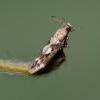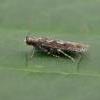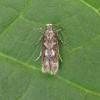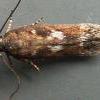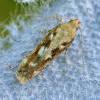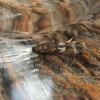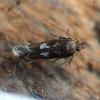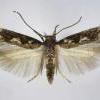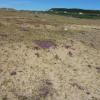35.131 Caryocolum marmorea (Haworth, 1828)
Status and Distribution
Local to locally common on sandy coasts throughout most of the British Isles, very patchy in its distribution in western Scotland but with strong colonies on the machair of the Hebrides; apparently absent from the Shetland Islands. Rare inland, occuring historically in good numbers in the Brecks and a flourishing colony occurred in an old sand-pit in Berkshire in the 1920s. More recent inland reports have been scattered and very sporadic suggesting these are wanderers from coastal areas.
Provisional map
Foodplant and Larval Feeding Signs
Cerastium fontanum (common mouse-ear), see plant distribution map, and C. semidecandrum (little mouse-ear). In Europe, also found on Silene nocteolens.
Commences as a leaf miner, then enters the plant stem and finally feeds externally on the basal leaves from a sand covered tube on the ground.
Habitat
Finding the Moth
Larva: can be found from late January onwards mining a single leaf of the foodplant before moving into the stem. The early feeding creates an irregular shaped semi-transparent upper surface mine usually near to the mid-rib along the length of the leaf and occassionally around the edge of the leaf at the tip. Greenish-brown frass may be deposited in small ammounts near the start of the mine but not always. Later the larva moves to external feeding constructing a sand-covered silken tube at ground level from which it feeds on the basal leaves of the plant.
Adult: can be readily disturbed during the day and later can come to light in good numbers.
Similar Species
C. marmorea is a medium-sized Caryocolum species showing considerable variation in forewing markings including almost unicolorous forms. It ranges from significant areas of pale ochreous scaling with little or no areas of white or black, to an extensively dark fuscous moth with little or no white scaling. The most regularly encountered form has a slightly flattened 'M' shaped dark fuscous mark in the basal two-thirds which has significant patches of white infilling the dorsal portions. The paler form and the 'M' marked form, with plenty of white scales are readily identifiable while the darkest or unicolorous forms will usually require dissection. This is particularly the case with dark forms of this species and C. alsinella.
One additional feature which may assist with the recognition of C. marmorea, and is unique within British Caryocolum species, is that the dark-coloured segment three of the labial palps is shorter than the lighter coloured segment two. In other species the two segments are of about similar length. This is a feature that is very tricky to judge in the field.
Single brooded in an extended flight period from late May to early September.
Earliest: 8th May 2007 (VC4)
Latest: 29th September 1994 (VC11)
On the scheme database there are about 400 records of adults and these display abundance peaks in late June and again in mid-August. There has been no indication so far in Britain or Europe from larval feeding reports that the species is double-brooded.

